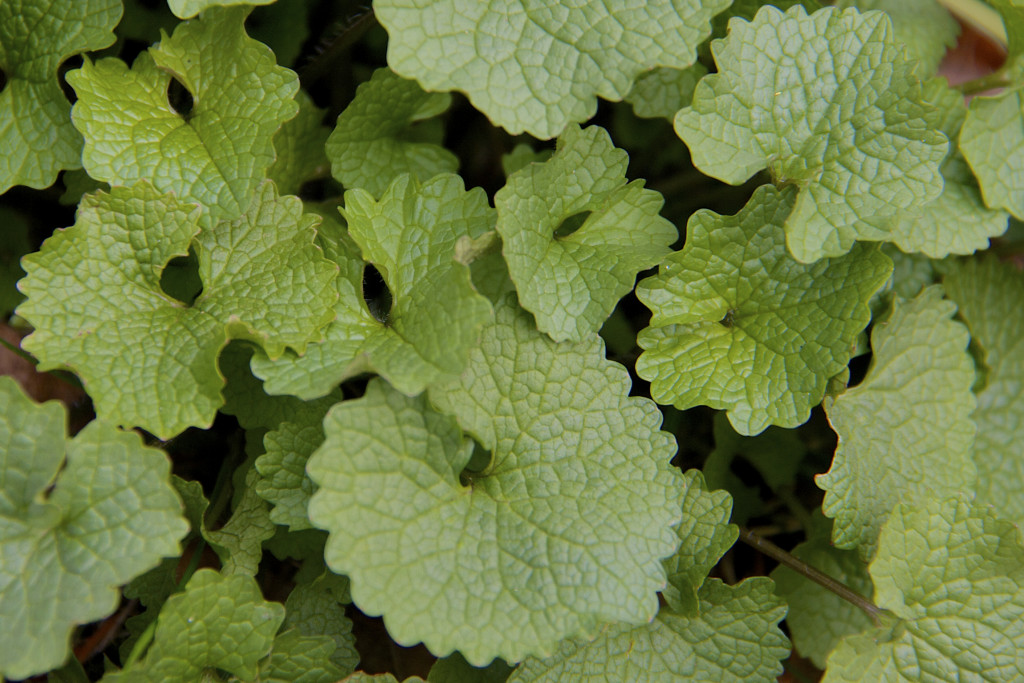
Poor, misunderstood garlic mustard.
There are multiple web pages devoted to the eradication of this plant (botanical name = Alliaria petiolata). But despite the fact that it’s an aggressive, invasive weed that crowds out many beloved natives, I can’t bring myself to be upset when I come across a patch of it in the woods. Because although it’s a thug in the landscape, it’s very tasty in the kitchen.
Garlic mustard is a successful plant, by which I mean it’s good at procreation. Here’s why:
- It has a tap root that allows it to tolerate a good amount of drought.
- It produces seeds that remain viable for up to five years, so you might think you’ve got it all, but you really haven’t.
- It has an allelopathic effect on surrounding soil, inhibiting the growth of nearby plants, and reducing competition.
- Its leaves emerge early in spring and it grows quickly, which gives garlic mustard a jump on open ground, crowding out less aggressive plants,
Native plant societies in areas besieged by garlic mustard often have spring meetings at which they remove great masses of the plant. But how many of them take it home to cook with? All parts of the plant have a strong garlic or mustard flavor (depending on the part), and there’s no reason why you shouldn’t make something tasty with the fruits of your labor.
First year foliage is my favorite part of garlic mustard. It’s most tender and tasty in cool weather (spring and fall). Leaves are kidney or heart shaped, with toothed margins, and grow in a basal rosette. Raw leaves make a sharp addition to salads and sandwiches. As a bitter green (bitter in a good way, like arugula and endive), the leaves combine well with mild greens in soups, stews, and pitas. Garlic mustard is also delicious in egg dishes like quiches, omelettes, and frittatas. Vodka infused with garlic mustard makes a savory martini. And garlic mustard pesto is a forager’s classic.
In summer of its second year, garlic mustard produces a flower stalk with four-petalled, white flowers. Young flower stems and unopened flower buds are also tasty, but after the flowers have opened the bloom stem may be too bitter, even for someone who likes bitter greens. Snap off a young stalk at its base, as you’d do with asparagus. Remove the leaves, then steam or sautée the stalks until tender. You can serve them as a simple vegetable or chop them up and add them to stews and soups.
Open flowers make a pretty garnish and can be sprinkled on salads for an arugula-like bite.
Some foragers appreciate the root of garlic mustard for its horseradish flavor, but I am not a fan of horseradish, so I don’t.
In addition to giving us so many different edible parts, garlic mustard is higher in beta-carotene, fiber, zinc, and vitamins C & E than either spinach or kale. (And it tastes SO much better than kale!) It’s also high in omega-3 fatty acids, iron, and calcium.
Are you convinced? At the very least, promise me you’ll keep an open mind. The next time you come across a generous patch of garlic mustard, bite into a leaf. You may still decide to yank up the entire plant, but I bet you’ll bring it back to your kitchen and make some wild foods magic.
We have this one all over our yard and I thought it was a different plant for years (I’m too embarrassed to say what plant). I looked more into it this year and gave it a try. I like it! I am excited to try cooking with it or adding it to different dishes. My dog really likes it too. I couldn’t find anything to suggest that it’s bad for him like regular garlic, but I hope it isn’t because there is nothing I can seem to do to keep him from eating it like crazy. Anyway, thank you for your wonderful knowledge!
You’re welcome, Katie! Let me know what you do with it. And let me know how your dog is…I’m not an expert on what dogs can and can’t eat.